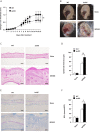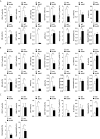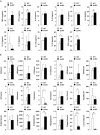Congenital Deficiency of Conventional Dendritic Cells Promotes the Development of Atopic Dermatitis-Like Inflammation
- PMID: 34394115
- PMCID: PMC8356667
- DOI: 10.3389/fimmu.2021.712676
Congenital Deficiency of Conventional Dendritic Cells Promotes the Development of Atopic Dermatitis-Like Inflammation
Abstract
Atopic dermatitis (AD) is a common pruritic inflammatory skin disease characterized by impaired epidermal barrier function and dysregulation of Thelper-2 (TH2)-biased immune responses. While the lineage of conventional dendritic cells (cDCs) are implicated to play decisive roles in T-cell immune responses, their requirement for the development of AD remains elusive. Here, we describe the impact of the constitutive loss of cDCs on the progression of AD-like inflammation by using binary transgenic (Tg) mice that constitutively lacked CD11chi cDCs. Unexpectedly, the congenital deficiency of cDCs not only exacerbates the pathogenesis of AD-like inflammation but also elicits immune abnormalities with the increased composition and function of granulocytes and group 2 innate lymphoid cells (ILC2) as well as B cells possibly mediated through the breakdown of the Fms-related tyrosine kinase 3 ligand (Flt3L)-mediated homeostatic feedback loop. Furthermore, the constitutive loss of cDCs accelerates skin colonization of Staphylococcus aureus (S. aureus), that associated with disease flare. Thus, cDCs maintains immune homeostasis to prevent the occurrence of immune abnormalities to maintain the functional skin barrier for mitigating AD flare.
Keywords: atopic dermatitis; dendritic cells; homeostatic feedback loop; immune homeostasis; type 2 immune responses.
Copyright © 2021 Nishikawa, Fukaya, Fukui, Uto, Takagi, Nasu, Miyanaga, Riethmacher, Choijookhuu, Hishikawa, Amano and Sato.
Conflict of interest statement
The authors declare that the research was conducted in the absence of any commercial or financial relationships that could be construed as a potential conflict of interest.
Figures






References
-
- Fukaya T, Takagi H, Sato Y, Sato K, Eizumi K, Taya H, et al. . Crucial Roles of B7-H1 and B7-DC Expressed on Mesenteric Lymph Node Dendritic Cells in the Generation of Antigen-Specific CD4+Foxp3+ Regulatory T Cells in the Establishment of Oral Tolerance. Blood (2010) 116(13):2266–76. 10.1182/blood-2009-10-250472 - DOI - PMC - PubMed
Publication types
MeSH terms
Substances
LinkOut - more resources
Full Text Sources
Molecular Biology Databases
Research Materials
Miscellaneous

